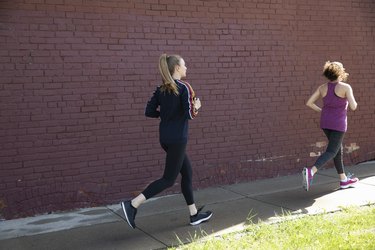
Medically speaking, your jiggly belly isn't as unhealthy as what lies beneath it. That's because a "poppin'-fresh" waistline is mainly subcutaneous fat.
The less-visible visceral abdominal fat under it poses more of a health risk. Fortunately, both fat types can be reduced through diet and exercise.
Video of the Day
Video of the Day
Get Cracking With Cardio
Getting enough aerobic exercise is a crucial building block to losing both the jiggly stomach fat on your upper belly and the lower abdominal fat that's often called a "stomach apron" because of its hanging quality. ("Spot training" moves like crunches strengthen muscle, rather than banish fat, so they won't target jiggly stomach fat.)
If you are relatively sedentary, adding even the minimum amount of recommended cardio for general health can jump-start the fat-burning process. Mayo Clinic advises getting at least 150 minutes of moderate cardio a week, or a minimum of 75 minutes a week of intense cardio. But for most people, 300 minutes of moderate cardio a week, or 150 minutes of vigorous cardio, will be needed to see changes in your belly and your overall body fat content.
So, which cardio type works better as a jiggly belly blaster? The kind that you're more likely to do! From a scientific standpoint, people who work out at either a moderate pace for a longer time, or an intense pace for a shorter period, will burn an equivalent number of calories. They also lose the same amount of belly fat over time.
Jiggly Belly-Blasting Workouts
The American Heart Association offers examples of moderate-intensity workouts. They include water aerobics class, walking briskly at about 3 mph, doubles tennis, cycling at medium speeds of less than 10 mph, and ballroom dancing.
If you're looking for time-saving, high-intensity aerobic activity, try aerobics class, cycling at 10 mph or faster, race walking, jogging, jumping rope, uphill hiking, heavy yard chores or vigorous laps.
Of course, with activities like walking and cycling, you can't always judge how fast you're going. If you don't have workout machines that measure speeds and intensity, you can self-monitor your physical activity intensity level by assigning a score of 1 to 20. This score is based on how much faster you think your heart is beating, how much your breathing rate increases, how tired your muscles get and how much you sweat. "Moderate" will be 11 to 14 on your scale, while "intense" would be 17 to 19.
Read more: The Truth Behind 5 Common Myths About HIIT
Avoid Dietary Pitfalls
To lose that jiggly belly and stomach apron as quickly as possible, limiting calories is still the name of the game. In addition to expending calories through exercise, restricting your caloric intake is also important. If you're not sure how much to take in, talk to your doctor or use an online calorie calculator that takes your age, height, current weight and activity level into account.
For your best shot of reducing body fat and losing pounds, make sure those calories aren't empty ones. Whole grains, fruits, vegetables, lean proteins and healthy fats continue to be the gold standard for a healthy diet. Add these to your daily meals if they're currently missing, while also focusing on cutting portion size, sugary beverages and snacks, fried foods and meat, and dairy high in saturated fat.
The American Council on Exercise offers a list of its favorite lower-calorie, low-fat foods to get you started if you're having trouble totally overhauling your diet. Suggested items include oatmeal, quinoa, barley, whole-grain crackers and bread, cucumbers, radishes, sweet peppers, broccoli, salad greens, and asparagus.
Bit of Bloat?
You may notice that frequent bloating is amplifying the appearance of a stomach apron and jiggly belly. If so, make some changes to your lifestyle.
According to Harvard Health Publishing, getting a bit of a "pooch" after eating might mean that you're a part of the population that has trouble digesting foods within the FODMAP (fermentable oligosaccharides, disaccharides, monosaccharides, and polyols) group. These include legumes, certain nuts, garlic, onions, wheat and rye.
It's also possible that you have a chronic condition such as irritable bowel syndrome. Keeping a food diary may help you determine if only certain foods give you that temporarily enlarged belly, or if it happens after most meals and calls for a visit to your physician.
- Harvard Health Publishing: "Abdominal Fat and What to Do About It"
- American Council on Exercise: "3 Fat Loss Myths to Stop Believing Now"
- Mayo Clinic: "Belly Fat in Women"
- Harvard Health Publishing: "Moderate- and High-Intensity Workout Both Burn Belly Fat"
- American Heart Association: "Moderate to Vigorous - What is Your Level of Intensity?"
- Mayo Clinic: "Calorie Calculator"
- American Council on Exercise: "Belly Bulge-Fighting Foods"
- Harvard Health Publishing: "What’s Causing That Belly Bloat?"
- U.S. Department of Health and Human Services: "Physical Activity Guidelines for Americans"
Was this article helpful?
150 Characters Max
0/150
Thank you for sharing!
Thank you for your feedback!